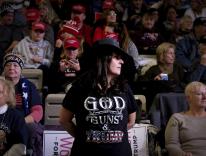I recently had occasion to attend Mass at two different local parishes. The church I more frequently visit is a plain, vaguely Romanesque wooden structure built in the nineteenth century. It looks very much like the church I went to as a child and where I received my First Communion and was confirmed, although it is smaller and the interior is not as ornate. My childhood parish is in Connecticut’s much more prosperous Fairfield County, while we now live Eastern Connecticut. Still, the long rectangular lanterns hanging from the ceiling and the amber-tinted stained-glass windows are strikingly like those in the church of my youth. I suspect the same liturgical furnishings were used because the two churches were built in roughly the same era.
The other church I attended a few days later is a modern, circular structure, whose stained glass is abstract in design and features bold colors. It is a much larger church, perhaps twice the size of the older building. Much of the Mass was sung, and there were familiar post-Vatican II hymns such as “Be Not Afraid.” I am perplexed as to why the Gloria is ever sung instead of recited, since in my experience it is unsingable, and few of those in the pews even attempted to sing along with the small choir. The Mass was well attended and the congregation a surprisingly diverse group. It was the fourth Sunday in Ordinary Time and the readings included passages from Deuteronomy, First Corinthians, and the Gospel of Mark. In the second reading, those of us who are married were helpfully reminded that “a married man is anxious about the things of this world, how he may please his wife, and he is divided.” True enough. The Gospel passage had Jesus demonstrating his authority by casting out an unclean spirit—not something you see every day, and presumably something that should not be dismissed as an anachronism.
The homily, delivered in a strong voice by the deacon, spent little time explicating the readings. The homilist’s focus was the Real Presence in the Eucharist, where, we were told, we meet the very same Jesus found in the Scriptures. Once again, true enough. Coincidentally, earlier in the same week a homilist at the other church also preached on the Real Presence. He commended us for being believers, which our presence at Mass attested to. He then complained that far too many Catholics no longer believe in the Real Presence. Many insist on their children receiving First Communion, but then rarely darken the church door again. Quoting that day’s Gospel reading, he implored us to go into the world and proclaim the Good News. We should tell those we meet outside of church about our faith in Jesus.
Perhaps the diocese has instructed the clergy to preach on the Real Presence; that would explain the focus of these homilies. At the second church, the homilist reminded the congregation of a recently deceased parishioner’s devotion to the Eucharist and her blissful reception of the sacrament. The vignette was well told and moving, but I have my doubts that such appeals from the pulpit, however eloquent, can restore a robust sense of the Real Presence among those who apparently have lost it. (I set aside the question of what Catholics actually believed in the past, or how they interpret survey questions about the sacrament today. I suspect belief was not as clear-cut in the old days as many priests seem to imagine.)
If the idea is to improve the average church-going Catholic’s understanding of the Eucharist, I think it is a mistake to catechize on the subject in the homily. That, in any case, is what a distinguished liturgist once told me, and I suspect he was right. If you have to explain the fundamentals just before confecting the sacrament, you are fighting a battle already lost. That sort of instruction—or better yet, initiation—has to take place elsewhere. Admittedly, the “elsewhere” is harder to locate than it used to be, but that doesn’t make it any less necessary. Instead of using the Sunday homily to patch up a fraying sense of the Real Presence, it would be better for homilists to lean into the truly strange world made present in Scripture. We need more exegesis and less exhortation. What, for example, could be stranger to most contemporary American Catholics than stories of Jesus casting out demons? I certainly find them bewildering. But Mark’s Gospel depicts a truly foreign country filled with demons and exorcisms. If a homilist leaned into that testimony with honest curiosity as well as conviction, he might broaden our sense of what is possible, what is real, and what is truly present.
Please email comments to [email protected] and join the conversation on our Facebook page.
Share
Previous Story
Damage & Survival
Next Story
Attention and Poetry

